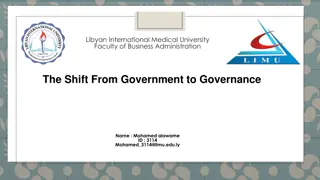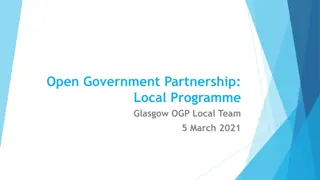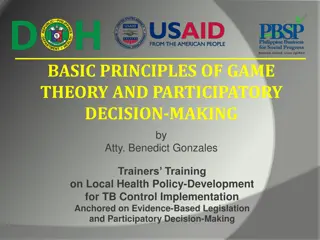Enhancing Student-Faculty Collaboration in Participatory Governance
Explore the significance of students and faculty working together in participatory governance within educational institutions. Learn about the history, value, and benefits of participatory governance, as well as the roles and responsibilities of various stakeholders. Discover how this collaborative approach fosters inclusivity, participation, and mutual respect through open communication and decision-making processes.
Download Presentation

Please find below an Image/Link to download the presentation.
The content on the website is provided AS IS for your information and personal use only. It may not be sold, licensed, or shared on other websites without obtaining consent from the author.If you encounter any issues during the download, it is possible that the publisher has removed the file from their server.
You are allowed to download the files provided on this website for personal or commercial use, subject to the condition that they are used lawfully. All files are the property of their respective owners.
The content on the website is provided AS IS for your information and personal use only. It may not be sold, licensed, or shared on other websites without obtaining consent from the author.
E N D
Presentation Transcript
Better Together: Students and Faculty Working Together in Participatory Governance
Angelica Campos, Outgoing SSCCC President Presenters Cheryl Aschenbach, ASCCC Vice President LaTonya Parker, ASCCC Secretary
Overview Why work together? Quick history of participatory governance Student 9+1, Faculty 10+1, & Areas of Overlap Ways students and faculty can partner in governance Helpful practices for participating together in governance Additional statewide opportunities and resources for you to access
History of Participatory Governance AB 1725 (Vasconcellos, 1988) Community College Reform Act Separated community colleges from K-12 Established framework for participatory governance CA Ed Code 70902(b)(7) Establish procedures that are consistent with minimum standards established by the board of governors to ensure faculty, staff, and students the opportunity to express their opinions at the campus level, to ensure that these opinions are given every reasonable consideration, to ensure the right to participate effectively in district and college governance, and to ensure the right of academic senates to assume primary responsibility for making recommendations in the areas of curriculum and academic standards. Title 5 Regulations further defined roles/responsibilities for students, faculty, and classified staff
What is the Value of Participatory Governance? Supports inclusiveness of individual and community viewpoints in collaborative decision-making processes Develops greater sense of participation and ownership Promotes mutual respect and trust through open communication and collaboration
Student 9+1 1. 2. 3. 4. 5. 6. 7. 8. 9. Grading Policies Codes of Student Conduct Academic disciplinary policies Curriculum development Courses or programs which should be initiated or discontinued Processes for institutional planning and budget development Standards and policies regarding student preparation and success Student services planning and development Student fees within the authority of the district to adopt The + 1 in student rights is meant to account for anything else that a college or district thinks will have a significant impact on students
Faculty 10+1 Academic and Professional Matters 1. 2. 3. 4. 5. 6. 7. 8. 9. 10. Processes for institutional planning and budget development Curriculum, including establishing prerequisites and placing courses within disciplines Degree and certificate requirements Grading policies Educational program development Standards or policies regarding student preparation and success District and college governance structures, as related to faculty roles Faculty roles and involvement in accreditation processes Policies for faculty professional development activities Processes for program review + 1 Other academic and professional matters
Areas of Overlap: Examples Grading policies, including plus/minus grading Facilities use and planning, including bonds Academic probation policies Planning processes, including for student services, instruction, technology, and more Hiring processes Program development and discontinuation Smoking/No Smoking policies Campus safety and policing
Areas of Overlap: Student Grievance Policy CCLC Board Policy Template AP 5530 Student Rights & Grievances Student-led effort Broad representation and collaboration Increase student accessibility to process Transition from complicated process to simpler process Recommended actions to take: Review current policy. Faculty & students connect to discuss it and consider updates.
Ways Students & Faculty Can Partner Identify areas of shared interest Student Body Association and Academic Senate leadership meetings / regular dialog Alert each other of concerns Share intentions, gather information, request support or collaboration as needed Sounding board Strategize for College Council or planning meetings Attend each other s meetings Shared orientation to participatory governance Overview of committee service opportunities Opportunity to identify faculty mentors Faculty introduced to student priorities and shared areas of interest
Helpful Practices for Participating in Governance Balance many different perspectives and seek inclusive solutions Engage others & invite them to participate in governance The easiest way to know what matters to peers is to talk to them! Students: Student government meetings SBA events and activities Clubs and your ICC Classes and friends Faculty: Hallway conversations Department or division meetings Lunch room or cafeteria Organize town halls for larger, more important issues
Committee Work As An Element of Governance Consider ways to increase and support students participation on committees Before meetings During meetings After meetings Student voice in governance is critical! Students: Have a presence. Participate. Faculty: Help make student presence & participation possible.
Before Meetings: Increasing & Supporting Student Participation Students: Faculty: Meet with committee chair prior to first meeting and at any point later Review past meeting agendas and minutes Speak with constituents to gather info & opinion on committee topics Get familiar with the committee terms Learn about the members of that committee, consider ways to form connections Pre-read the agenda and make sure that you are aware of which sections require student input Reach out to SBA leadership to get contact info for appointed students Work with student schedules when scheduling meetings Consider being a mentor to students Reach out to appointed students, arrange to meet informally Offer background & context for committee work Offer to review the agenda
During Meetings: Increasing & Supporting Student Participation Students: Bring something to take notes with! Questions to ask yourself: Are there other factors this committee should be considering in their work or discussion? Is there a different approach I want this committee to consider? Is there any background knowledge I am lacking in the discussion that I need to ask about? Are there any assumptions the committee is making about the student perspective that is incorrect and which I need to give my input on? How can I address the student issues that are coming up in my committee s work? Is there information or decisions I need to take back to my SBA? Don t forget to ask questions! Your voice and perspective are valuable!
During Meetings: Increasing & Supporting Student Participation Faculty: Questions to ask yourself about student participation: Are there any assumptions the committee or I am making about the student perspective that is incorrect and which student input should be encouraged? How can I encourage student voice in committee discussions? How can I support the perspectives being brought up by students during the committee s work? How can I help colleagues recognize the value of student voice? Strategies to increase student participation during meetings Ask students to share their perspectives and ideas on issues being discussed Actively listen and support student ideas
After Meetings: Increasing & Supporting Student Participation Report back to your SBA or academic senate Identify which information should be brought back to your peers Identify which topics require further action by SBA or academic senate Continue to attend future meetings, remain engaged, and regularly communicate with the chair of your committee Keep an alternate representative ready in the case you are not able to attend a committee meeting Inform the alternate representative of anything pertinent to the committee Follow-up with chair or a committee member if you miss a meeting Prepare for the next meeting!
The New Majority: Today s College Students
Stay Involved. Find Additional Resources Students: Apply to sit on one of the SSCCC s external committees: https://docs.google.com/forms/d/e/1FAIpQLScRCEXejwZsb6jhR3GaAcQ tRCfuLWISsuhBFpYAw5nTg4KDpw/viewform SSCCC Participatory Resources: https://ssccc.org/get-involved/participatory-governance.html Faculty: Apply to serve on an ASCCC Committee: https://asccc.org/content/new-faculty-application-statewide-service Faculty: Local Senates Handbook: https://asccc.org/papers/handbook2015
Stay Connected! www.ssccc.org www.asccc.org SSCCC_Official academic_senateccc SSCCC_Official ASCCCNews Academic Senate for California Community Colleges Student Senate for California Community Colleges























